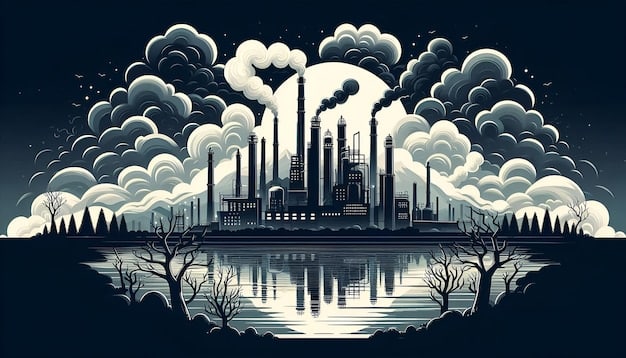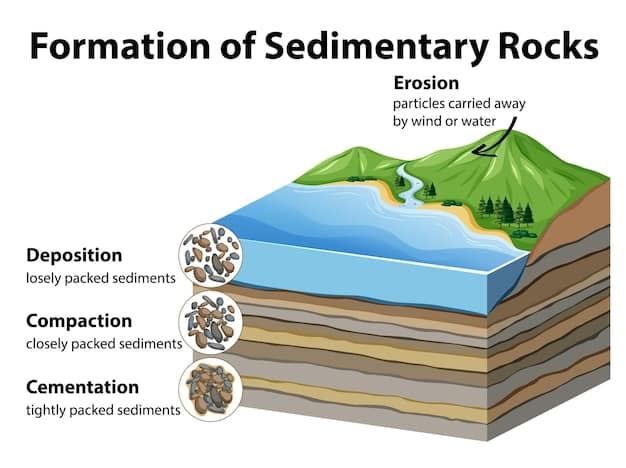The Science Behind Climate Change Mitigation: Carbon Capture Technologies Evaluated

The Science Behind Climate Change Mitigation: Evaluating the Effectiveness of Carbon Capture Technologies is crucial for addressing global warming. This article explores the science underpinning these technologies, examining their potential and limitations in reducing atmospheric carbon dioxide.
Climate change is one of the most pressing issues facing humanity today. As greenhouse gas emissions continue to rise, the need for effective mitigation strategies becomes increasingly urgent. Among the various approaches being explored, the Science Behind Climate Change Mitigation: Evaluating the Effectiveness of Carbon Capture Technologies has gained significant attention.
This article delves into the scientific principles behind carbon capture technologies, assessing their potential to reduce atmospheric carbon dioxide and combat climate change. It aims to provide a comprehensive overview of the current state of the field, evaluating the effectiveness, challenges, and future prospects of these technologies.
Understanding the Basics of Carbon Capture
Carbon capture technologies aim to prevent large quantities of CO2 from being released into the atmosphere. These technologies work by capturing CO2 emissions from sources like power plants and industrial facilities, or directly from the air, and then storing it permanently underground or utilizing it in various industrial processes.
Different Approaches to Carbon Capture
There are several methods for capturing carbon dioxide, each with its own advantages and limitations.
- Pre-combustion capture: This involves converting fuel into a mixture of hydrogen and carbon dioxide before combustion. The CO2 is then separated, leaving hydrogen to be used as a clean energy source.
- Post-combustion capture: This method captures CO2 from the flue gas after the fuel has been burned. It is often used in existing power plants because it can be retrofitted to current infrastructure.
- Oxy-fuel combustion: Here, fuel is burned in pure oxygen instead of air, producing a flue gas that is almost entirely CO2 and water. This makes it easier to capture the CO2.

The choice of method depends on the specific application and the characteristics of the emission source. Each approach requires significant energy input, which can affect the overall effectiveness of the carbon capture process.
In summary, understanding the different carbon capture methods is essential for implementing effective climate change mitigation strategies. The selection of the appropriate method depends on various factors, including the source of emissions, cost considerations, and energy efficiency.
The Science Behind Carbon Dioxide Absorption
The absorption of carbon dioxide is a crucial step in many carbon capture processes. Understanding the chemical and physical principles behind this process is fundamental to improving the efficiency and effectiveness of carbon capture technologies.
Chemical Absorption
Chemical absorption involves the use of solvents that react chemically with CO2 to form a stable compound. These solvents are typically amine-based and can capture CO2 from flue gas with high efficiency.
The process works by bringing the flue gas into contact with the solvent in an absorber tower. The solvent reacts with the CO2, binding it chemically. The CO2-rich solvent is then heated in a stripper, releasing the CO2, which can be collected and stored.
Physical Absorption
Physical absorption relies on the physical properties of certain solvents to dissolve CO2. These solvents are often used at high pressures and low temperatures, where CO2 is more soluble.
- Advantages: Physical absorption solvents can capture CO2 without a chemical reaction, reducing energy consumption during regeneration.
- Limitations: This method is typically more effective at higher CO2 concentrations, making it less suitable for applications like direct air capture.
- Common solvents: Examples include methanol and other organic solvents that exhibit high selectivity for CO2 under specific conditions.
In conclusion, both chemical and physical absorption play significant roles in carbon capture technologies. The choice between them depends on factors such as the concentration of CO2 in the source gas and the desired efficiency and energy consumption of the capture process.
Exploring Carbon Storage Methods
Once carbon dioxide is captured, it must be stored in a way that prevents it from re-entering the atmosphere. There are several methods for long-term carbon storage, each with its own geological and environmental considerations.
Geological Storage
Geological storage involves injecting captured CO2 deep underground into porous rock formations, similar to how oil and gas are stored naturally. These formations are typically located several kilometers beneath the Earth’s surface and are capped by impermeable layers of rock that prevent the CO2 from escaping.
The process requires careful site selection to ensure that the geological formation is suitable for long-term storage. Factors such as porosity, permeability, and the presence of sealing layers are crucial for the success of geological storage.

Mineral Carbonation
Mineral carbonation involves reacting CO2 with minerals to form stable carbonates. This process permanently locks the CO2 in a solid form, eliminating the risk of leakage.
- Process: The CO2 is reacted with minerals such as magnesium oxide or calcium oxide to form carbonates.
- Advantages: Mineral carbonation offers a very stable and permanent form of carbon storage.
- Challenges: This process can be energy-intensive, and finding suitable minerals in large quantities can be challenging.
In summary, effective carbon storage is essential for the success of carbon capture technologies. Geological storage and mineral carbonation offer promising solutions for long-term carbon sequestration, each with its own set of considerations and challenges.
The Role of Direct Air Capture in Mitigation
Direct air capture (DAC) involves extracting CO2 directly from the atmosphere. Unlike point-source capture, which targets emissions from specific sources, DAC can capture CO2 from anywhere in the world, making it a potentially powerful tool for mitigating climate change.
How Direct Air Capture Works
DAC plants use specialized filters and chemical processes to capture CO2 from the air. The air is drawn through the filters, which selectively bind to CO2 molecules. The CO2 is then released from the filters and collected for storage or utilization.
There are two main types of DAC technologies: solid sorbent systems and liquid solvent systems. Solid sorbent systems use solid materials to capture CO2, while liquid solvent systems use liquid solutions. Both approaches require significant energy input, but ongoing research is focused on improving their efficiency.
Challenges and Opportunities
Direct air capture faces several challenges, including high energy consumption and costs. However, it also offers unique opportunities for mitigating climate change.
**The Science Behind Climate Change Mitigation: Evaluating the Effectiveness of Carbon Capture Technologies** is crucial in understanding these challenges. Some factors to consider include:
- Scalability: DAC plants can be located anywhere, allowing for deployment in areas with abundant renewable energy sources.
- Negative emissions: DAC can remove CO2 that has already been emitted, leading to net-negative emissions.
- Integration with storage sites: DAC plants can be located near geological storage sites, reducing transportation costs and risks.
In conclusion, direct air capture has the potential to play a significant role in mitigating climate change by removing CO2 directly from the atmosphere. Overcoming the challenges related to energy consumption and costs will be crucial for realizing its full potential.
Evaluating the Effectiveness of Carbon Capture Technologies
To effectively combat climate change, it’s important to look at the big picture. Understanding what makes these technologies effective is crucial for making informed decisions.
The Science Behind Climate Change Mitigation: Evaluating the Effectiveness of Carbon Capture Technologies
Several factors determine the effectiveness of carbon capture technologies, including the capture rate, energy consumption, and overall cost. Evaluating these factors is essential for determining the viability and scalability of different carbon capture approaches.
According to the latest research, here are some important factors:
- Capture Rate: The percentage of CO2 emissions that a technology can capture from a source.
- Energy Consumption: The amount of energy required to operate the carbon capture process. The energy consumption can significantly impact the overall carbon footprint of the technology.
- Cost: The economic feasibility of deploying carbon capture technologies on a large scale. High costs can hinder widespread adoption.
In summary, evaluating the effectiveness of carbon capture technologies requires a comprehensive assessment of various factors, including capture rate, energy consumption, and cost. Continuous research and development are essential for improving the performance and reducing the costs of these technologies.
| Key Aspect | Brief Description |
|---|---|
| 💡 Capture Methods | Pre-combustion, post-combustion, and oxy-fuel combustion are key techniques. |
| 🌍 Storage Options | Geological storage and mineral carbonation are viable long-term solutions. |
| 🌱 Direct Air Capture | DAC removes CO2 directly from the atmosphere, offering global deployment. |
| 💰 Effectiveness Factors | Capture rate, energy consumption, and cost are key determinants. |
Frequently Asked Questions
It involves capturing CO2 emissions from sources like power plants or directly from the air. It then transforms and safely stores them to prevent their release into the atmosphere, which aids in climate control.
Geological storage involves injecting captured CO2 deep underground into porous rock formations. These formations are capped by impermeable layers of rock that prevent the CO2 from escaping.
The primary challenges include high energy consumption, substantial costs, and the need for further technological advancements to improve efficiency in capturing CO2. Addressing these difficulties is vital.
Mineral carbonation involves reacting CO2 with minerals to form stable carbonates. This permanently locks the CO2 in a solid form, eliminating the risk of leakage, effectively and safely controlling its effect on the environment.
Evaluating effectiveness, including capture rate, energy use, and costs, ensures viable, scalable deployment, enabling climate change mitigation. Efficient deployment guarantees long-term solutions and sustainability.
Conclusion
The Science Behind Climate Change Mitigation: Evaluating the Effectiveness of Carbon Capture Technologies is critical for addressing climate change. These technologies offer various solutions, from capturing emissions at their source to extracting CO2 directly from the atmosphere.
Despite the challenges, ongoing research and development are paving the way for more efficient and cost-effective carbon capture approaches. By understanding the science behind these technologies and evaluating their effectiveness, we can move towards a more sustainable future.





